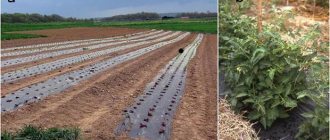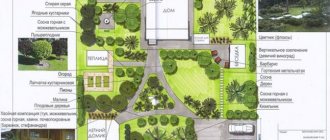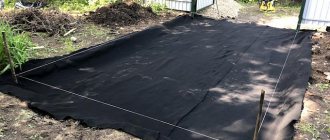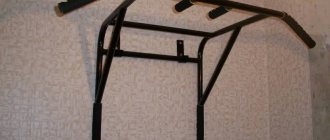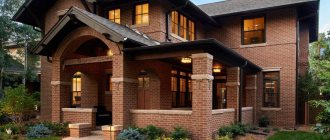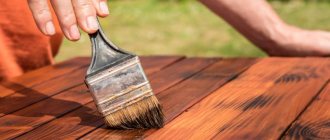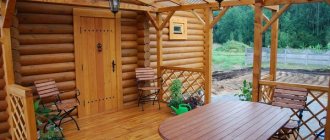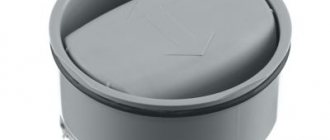Photo: zen.yandex.ru Many summer residents suffer from poor soil, proximity to groundwater and other problems that make planting seedlings seem impossible. This is exactly what raised beds are for! You don’t have to constantly bend down, and plants don’t have to fight for nutrients with weeds and tree rhizomes. Complete amenities that you can arrange with your own hands!
Rationalization of labor - mulching
Areas of the garden that do not have cultivated plants are the first to become overgrown with weeds, so they have to be weeded more often. If you stop cultivating such areas and start caring only for useful areas, you can reduce labor costs by more than half. But empty spaces cannot be left completely unattended either. They must be thoroughly mulched with fallen leaves, sawdust or straw.
Almost all plants die under a dense layer of mulch. It needs to be laid once, and then updated about once a year. In addition, the mulch must be turned up periodically to disrupt the rooting processes of weeds growing in it.
Mulching is a very useful agricultural technique that does not have any disadvantages. Using a layer of natural plant materials helps not only protect against excess vegetation, but also retain moisture in the soil, therefore saving time on watering.
Planning a vegetable garden
If you already have a summer house or a plot of land near your house, you have probably already encountered a situation of an overabundance of fruits, vegetables and berries. When the harvest has to be distributed to relatives, neighbors, and colleagues. But in order to grow it, a lot of effort had to be made. To avoid such a situation, it is necessary to plan the harvest. It’s clear that you won’t get great accuracy, but results close to the planned ones are possible.
A smart vegetable garden is also a decoration of the site
We count the area of the beds
The first thing to do is sit down and think about what and how much you want to grow. The specific quantity is in kilograms. How much do you need to “eat” and “close”. Write a list of plants (in a column) and the desired harvest.
Having decided on the list of plants that you want to grow in your home, we sit down and look at the average yield that can be achieved when grown in smart beds. It is given in the table. Since you are still an inexperienced “lazy gardener”, reduce it by half. We put numbers next to each of the plants. It must be recorded in kilograms per square meter of area.
Approximate yield of vegetables and herbs when grown in smart beds
Now it’s easy to calculate how much area you need to allocate for each type of plant: divide the desired yield in kilograms by the average yield for each type of plant. We get the square footage for vegetables, berries, herbs, etc. If we add up all these areas, we will find out how many beds you need in total. These are the beds that should be placed on your site.
You're probably surprised by how little space you need for garden beds. And it's really not enough. Many times less than what we are used to! You will have very little land to cultivate. The freed up space can be used for flower beds, rockeries, fountains and other decorations.
Where to place
When planning smart beds, you need to take into account the degree of illumination. Almost all the plants you need prefer sunny places. In partial shade you can grow rhubarb, sorrel, and onions (including feathers). Perhaps that's all. There are no garden plants that grow well in shaded areas. Or rather, they will grow, but the yield will decrease by 3-4 times. Shaded areas should be set aside as a recreation area or a flower bed with shade-loving plants should be placed there.
Layout of beds: only in the sun
Another principle for placing beds: the more care (read watering) a crop requires, the closer to the entrance to the house it should be located:
- There should be a greenhouse with seedlings right next to the exit.
- Nearby there is a bed for radishes and salad.
- Right there or a little further - tomatoes, cucumbers, greens.
- Even further - peppers, eggplants, cabbage of various types, beans, root vegetables.
- In the back there are potatoes, pumpkins, squash, corn, sunflowers and perennials.
- The farthest thing is the garden.
Beds with capricious plants are located as close to the house as possible
Why arrange the plants this way? Because at the beginning of the watering/weeding work, gardeners are full of enthusiasm and the plants receive more water, weeds are removed more thoroughly. Gradually, the fervor subsides, less and less water is available per square area, and processing becomes less thorough. And with the approach proposed above, the amount of water will be “just right” and everything will be fine with soil cultivation.
Orientation to cardinal directions and precise location determination
If you want to get a harvest from the entire area of the lazy bed, the location is north-south. Strictly. This is the only way the entire area will bear fruit. Also place trellises for climbing vegetables. Although, they can be planted along the southern and eastern walls of buildings.
For a smart garden to also be beautiful, you need to think about where to place the beds. To do this, take a scale plan of the site indicating the direction to north/south. On it we draw all the buildings and main paths, water supply (we pay special attention to the position of the taps), trees and shrubs. On the plan we immediately outline the shadow zones - we will not place vegetables here, this is a place for flowers, gazebos, fountains.
One of the beds for a smart vegetable garden: a high bed
We cut out the beds from paper (on the same scale as the site plan). Moreover, we make them in the shape that we plan: rectangle, square, circle, triangle, etc. The shape is selected based on the area planned for the crop. And it doesn’t have to be a boring rectangle. Since there will be enough free space (you remember that you need much less beds), rationalism fades into the background, and the main emphasis is on aesthetics. After all, few people work in their dachas “so that they have something to eat”; mostly it’s also a pleasure. And what could be more pleasant than the beauty of a cultivated plot?
So, we sign each piece of paper indicating a smart bed - we put the name of the crop or crops (you can grow two, three or more on one bed). Now we are looking for a place for each, taking into account the rules described above. Along the way, you can change the shape of smart beds: for the sake of beauty or convenience. When you have found the places, trace the contours and transfer the inscriptions. All that remains is to implement our plans.
Exclusion from circulation of empty beds
The second rule of successful weed control follows from the first - there should be no empty beds. If there remains a fairly large area that is inconvenient to mulch, then you need to sow it with green manure crops, usually grains or legumes. The choice of green manure plant depends on what you plan to grow after it. For example, for the most common ones - nightshade and pumpkin - wheat should be sown.
Related article:
Using copper sulfate in the garden
When the seedlings grow a little, they are plowed or dug up and buried in the ground. This approach is used in organic farming not only to prevent the growth of weeds, but also to improve the structure and enrich the soil with nutrients.
Some tricks
The technology is called smart gardening for a reason. You can test different approaches, new products, and the experience of “colleagues.” There are several tricks that come with use. We have already talked about one - about covering material. It really makes maintenance a lot easier and there is no need for mulch. There are other interesting ideas:
- After crops that are “heavy” for the soil, sow oats, peas, mustard, and rapeseed. After a couple of weeks, juicy greenery grows. It can be left “under the snow” and dug up in the spring. Or dig it up just before the snow, along with the greens. The goal here is twofold - the young greenery rots, enriching the earth. This time. And two - weeds do not grow, since the shoots are friendly. This harvest makes my heart happy
- Use white covering material to extend the summer season and get an early harvest. Arcs are made from steel rod with a diameter of 8-10 mm. Drawstrings 2 cm wide or more are sewn into medium or high density spunbond. Arcs are inserted into them, spunbond is assembled on the wire so that the ends of the wire are free. The portable mini-greenhouse is ready. Stick arcs in at both ends of the bed. To protect the plants from frost, straighten the spunbond; you can open it for the day by collecting all the material on one side. The same design will also save you from overheating in the summer heat.
- Place a large metal barrel in the corner of the site. Place weeds and other plant waste in it. To fill with water. The greens will quickly rot and this slurry can be used for feeding. You just need to cover the barrel - the contents don't smell the best.
Systematic care of beds
Weeds should be removed between cultivated plants and in the mulch layer daily, working for 10–30 minutes. Small sprouts are removed much easier and faster; moreover, weak roots do not have time to gain a foothold in the soil and, when pulled out, do not harm the crops growing nearby.
For these reasons, 30 minutes a day will be much more effective than 3.5 hours once a week. Therefore, you need to work every day and little by little.
Mulch
Almost every gardener knows about the benefits of mulching, but it is not always possible to find material for mulch. Weeds come to the rescue. After weeding, they need to be laid out under herbaceous plants or trees. This is a completely safe, natural and environmentally friendly type of mulching material. The only thing is that you need to be careful with those crops that can easily be affected by fungal diseases. Mulch from weeds gradually turns into organic matter, replenishing its reserves in the substrate.
There is an important clarification: for mulching after weeding, only those grasses on which the seeds have not yet ripened are suitable, otherwise the seedlings will continue to actively germinate throughout the season.
Using drip irrigation
Drip irrigation involves supplying water only to the root system of garden crops. As a result, empty areas will remain without moisture, so weeds will sprout and grow there more slowly.
In addition, this water supply is most consistent with the natural flow of moisture to the roots. It prevents cracking of the ground surface during dry periods and saves water.
What methods can you use to make a garden bed from scratch without weeds, ideas and expert advice?
Fighting unwanted vegetation takes a lot of time and effort, so everyone is interested in the question: how to make a garden bed from scratch without weeds? To prevent the growth of weeds, a number of preparatory work must be carried out. The soil is dug up, weed roots are removed from it, leveled, and covered with mulch film. Overgrown weeds in an open field are mowed, pulled out or sprayed with chemicals.
The main types of weeds growing in gardens
All gardeners, without exception, know that in order to get a good harvest, the land on which crops grow needs to be fertilized and watered. True, concern for soil fertility leads to weeds growing in the garden instead of sown plants.
Weeds are characterized by faster development, resistance to any weather conditions, and aggressive spread. They take away water and nutrients from the main crops. In the struggle for existence in the garden, cultivated plants often lose.
Weeds and control measures:
- ragweed (mulching, weeding, treatment with Roundup, Tornado pesticides);
- thistle (weeding, spraying with herbicides Tornado, Lapis lazuli);
- bindweed (digging the soil, repeated cutting, treatment with herbicides Chistoryad, Ground);
- knotweed (weeding, spraying with pesticides Gesagard, Betanal);
- woodlice (soil mulching, weeding, use of chemicals Pyramin, Difenamide);
- field fire (mulching, weeding, herbicides calcium cyanamide, diphenamide);
- nettle (weeding, digging soil, mulching beds, spraying with pesticides Glyphos, Tornado);
- milkweed (weeding, treatment with herbicides Esteron, Chistalan);
- dandelion (mulching, weeding, irrigation with pesticides Agroxon, Metaphen);
- plantain (weeding, treatment with herbicides Lontrel, Ballet);
- wheatgrass (digging soil, weeding, mulching);
- thistle (digging soil, weeding).
Weeds are combated as they appear. As a preventive measure, the soil in the garden is dug up in the fall. When you turn over a layer of earth, weed roots appear on the surface, which are simply selected. There are other measures to combat unwanted vegetation.
How to organize a bed without weeds
Unwanted vegetation must be dealt with systematically and consistently. If it is left unattended for some time, then soon the entire garden will be filled with weeds. Simple ideas and ways to control weeds will help gardeners win this difficult battle.
Herbicide treatment
You can deal with weeds without weeding. Herbicides have been used on large farms for many decades, but only a few are used in personal gardens. These chemicals make it possible to quickly deal with any weeds without much difficulty.
Herbicides (Lontrel, Roundup, Lazurit) have selective activity, that is, they act only on weeds and do not cause any harm to cultivated plants.
You can buy the herbicide at any department that sells seeds or fertilizers. Before use, the drugs are diluted with water in the dosage indicated in the instructions. Typically, field treatment with a herbicide solution is carried out in early spring, before or after sowing. Young weeds are sprayed with herbicides.
Chemicals burn or cause weeds to wilt, and after a few weeks they completely disintegrate in the soil.
Mechanical struggle for purity
In order to get rid of weeds, you need to fight them. The easiest way is to cut weeds at the root. True, after some time they will grow again. If new shoots appear, they are removed again. Eventually, the plant will run out of strength, it will not be able to reproduce the above-ground part and will die.
Mowing is used to control perennials. Annuals can be defeated by weeding. Weeds, along with their roots, are pulled out of the ground. For weeding, use a hoe or a Fokina flat cutter.
Freezing compost
During the composting process, the weed seeds contained in it can be stored and then germinate after being applied to the soil. To prevent this from happening, you need to add such organic matter before winter or in early spring, when return frosts are expected.
At the same time, it is important that the seeds do not freeze themselves, but have time to sprout. It is the sprouted sprouts or young shoots that will most quickly die from the cold.
Related article:
Unfortunate neighborhood: 7 pairs of plants that are not recommended to be grown nearby
Design and design features for different areas
Projects on how to make a smart garden bed were developed in parallel by several domestic and foreign agronomists. One of the pioneers in this area was Igor Lyadov, who lives in the Far East. The basis for his original method was the experience of Jacob Mittlider. The fundamental difference was the replacement of mineral fertilizers with organic ones, including our own development of mixtures based on bird droppings, manure and herbs.
The width of the bed is 60-100 cm. Passages are made of a similar width. The location of the beds is strictly from north to south.
Preparation of Igor Lyadov’s smart vegetable garden begins in the fall. During this period, wooden boxes are manufactured and installed. To protect them from destruction, they are treated with protective impregnation or painted. You can use any available materials as the basis for the box. Organic residues are poured inside, which begin to rot over the winter, forming an environment favorable for plants.
In the southern arid regions, the N.I. project is popular. Kurdyumova. Being a native of the Black Sea region, he adapted the technique to suit the conditions. To set up Kurdyumov’s smart beds, you don’t need to raise them. Instead, you will need to dig a trench, which is then filled with compost, mulch and organic fertilizers.
The principle of how to make a smart garden bed is based on maintaining temperature conditions and moderate humidity. Moreover, practice shows that the processes are interconnected. Thus, maintaining the proper level of moisture protects against pests, and also starts the process of overheating organic matter, which warms the soil from the inside. To speed up the process of warming up the bed, it is recommended to cover it with black cloth or film in the spring.
Video materials
Below is a selection of materials that clearly shows the algorithm for creating a smart garden bed, including a video for the elderly:
Strengthening garden crops
If garden crops begin to actively develop before the weeds, they will choke them out and stop their growth. You can help cultural plantings in the following ways:
- Use the seedling growing method, in which plants are planted in the ground already formed. This not only gives them a time advantage, but also eliminates the need to rely on germination, which is not good for all seeds. In addition, before the first weeding, the crops will have time to take root well and will not suffer much when pulling out the weeds.
- Conduct timely fertilizing in accordance with the needs of each crop. Getting enough nutrients will also help plants grow faster. In this case, the application should be at the root or along the foliage so that nothing gets to the weeds.
As a result of this approach, the garden will develop more actively than weeds, and the beds will be cleaner and easier to maintain.
Other weed control methods
Every plant, including weeds, spends a lot of time recovering. Therefore, when periodically cutting off the top of the plants, they will lose a lot of strength to restore their greenery. Because of this, their root system will suffer. If you repeat this procedure several times a season, then you don’t have to worry about weeds, because they will simply lose the strength to grow greenery. This method is quite effective and is in demand among gardeners, but it requires a lot of effort and patience.
Quite often, the cause of weeds is the gardeners themselves, who pay little attention to their beds. The reason lies in the fact that summer residents use low-quality manure and fertilizers. Humus often contains weed seeds. If you use incompletely prepared fertilizer, you can breed a lot of weeds in your garden bed. If compost is prepared correctly, the weed seeds will simply “burn” in the fertilizer.
Another option to get rid of weed plants is the use of special covering materials. Agrofibre, roofing felt and ordinary black film are very popular. This solution is especially relevant for planting strawberries from strawberries. Small holes should be left for the bushes to fully develop. Weeds will not be able to grow. An excellent alternative to roofing felt, which can release resins, is organic mulch. Often wood bark, sawdust or straw are used for this. In addition, such a solution will also make the beds more attractive from an aesthetic point of view.
Weed mulch
The main task of the mulch layer is to block the access of sunlight to weeds. Without light they die. To achieve this goal, the mulch layer must be thick enough.
Not all gardeners like to use artificial mulch. Many people consider such a flower garden unnatural. To prevent weeds from growing, they are ready to weed the flower beds weekly, but at the same time admire the natural picture of their flower garden.
But if the area you have chosen for a flower garden is heavily infested with weeds, then it is better to put up with a somewhat “unnatural” appearance of the flower bed than to spend many hours weeding the flower garden.
Mulching a flower garden can be done using any suitable materials currently on hand:
- straw;
- mown weeds;
- cardboard;
- newspapers laid in several layers;
- tree bark.
When mulching a flower bed with such organic materials, over time they rot and act as fertilizers, simultaneously improving the soil structure. Mulched soil retains moisture better and improves the microclimate.
Mulching the area with tree bark.
Mulch made from organic materials does not last long. As a rule, within a few seasons it completely rots and then requires restoration. But it significantly reduces the growth of weeds and has a beneficial effect on the growth of cultivated plants. Therefore, tree bark mulch is widely used in garden design.
If you are not satisfied with the short-term effect of mulching with natural materials, you can use artificial mulch made from non-woven material or geotextile. This type of mulch also does not last forever, but it lasts much longer than organic mulch. After some time it also requires recovery. For greater decorativeness, a special layer of bark, sand, pebbles or gravel is laid on top of the film.
To prepare an area heavily infested with weeds for a flower bed, you can use the method of mulching with non-woven material or geotextiles. To do this, cover the selected area with film, pressing the edges with bricks, and keep it for about a year. During this time, the weeds will completely disappear. After this, the film is removed, the area is carefully dug up and sowed with green manure to improve the soil structure. As a result, you will get a weed-free area with loose, soft soil, quite suitable for growing flowers on it.
How to properly mulch a flower garden with bark
The bark of coniferous or deciduous trees, laid out as mulch, decorates the flower garden. It is better when the bark is laid directly on the ground, but in some cases geotextiles can be laid under it. Then the mulch will last longer.
Bark mulch has the following benefits:
- retains moisture in the soil and helps prevent soil drying out;
- significantly inhibits or completely eliminates the growth of weeds;
- decomposing, the bark saturates the soil with useful elements;
- gives the flower garden a beautiful look.
If your garden plot is located near a forest, then you can collect the required amount of bark there to mulch the flower garden. The most successful way to mulch a flower bed is with the bark of coniferous trees. You can grind the bark with a special grinder or simply by hand.
It is especially important to add mulch to new flower beds. It is in new flower beds that the distances between plants are quite large
After the flowers grow, they will cover all the free spaces and the mulch will not be visible. But she will still perform her tasks.
Non-woven fabric or weed control fabric
Weed control geotextiles are black and do not allow daylight to pass through. Therefore, weeds cannot grow under it. At the same time, geotextiles conduct water well. It is saturated with moisture and releases it to the soil during rain or when watering. The soil under the spunbond remains moist for a long time and a crust does not form on it. A flower bed with filling looks very decorative. Textiles help improve soil structure and develop soil fauna.
You can choose Agrospan 60 as a non-woven material to inhibit the growth of weeds. It is created on the basis of black non-woven material using spunbond technology. Agrospan 60 will reliably protect the flower bed from weeds, retain moisture in the soil, and improve its structure due to the formation of microfauna.
Folk remedies
Folk remedies will help fight weeds in the garden. They do not act as radically as chemical ones, but they do not pose a danger. Plants and soil need to be sprayed when the weather is dry and warm.
Solutions should not get on the leaves, flowers and stems of garden and ornamental plants. Rain, dampness and extreme heat significantly weaken the effect of the prepared solutions, as their concentration level changes.
Effective folk remedies include:
- alcohol;
- soda;
- salt;
- vinegar;
- herbicidal soap;
- gasoline or kerosene.
Alcohol
With the help of medical alcohol, we remove weeds this year and get rid of them next year. Alcohol (medicinal) should be diluted with water in a ratio of 1:10. The resulting solution is used to cultivate the soil between the plants. 11 liters of solution is more than enough to process more than 2 acres.
Soda
To cultivate the soil around the plants, make a strong soda solution. The liquid effectively destroys grass, as it contains a large amount of alkali. And if you add grated laundry soap to the soda solution, this will increase its destructive power.
Salt
The area overgrown with grass should be thoroughly covered with salt. Once absorbed into the soil, it will not only destroy existing weeds, but also prevent new ones from sprouting.
Vinegar
Effectively affects young weeds before they begin to form seeds. Vinegar is applied to the leaves and stems of the plant. The procedure must be performed carefully so that the liquid does not get on the garden plants. For these purposes, you can use a spray bottle or pump.
There are several vinegar-based recipes:
- Dilute 5 glasses of 6% vinegar in 2 liters of water. This solution can treat 2 acres of land;
- Mix 3 parts of 9% vinegar with 1 part lemon juice;
- Mix 5 tablespoons of vinegar with 2 tablespoons of salt and dissolve in 1 liter of water. This solution is used hot. It is one of the most effective solutions.
Herbicidal soap
Mix:
- 1 liter of white vinegar;
- 150 g table salt;
- 1 syringe of liquid soap;
- grated laundry soap.
All components are shaken until a homogeneous solution is obtained. Then, the resulting solution is used to treat the ground under the weeds. To achieve maximum effect, it is better to use strong vinegar – 15-20%.
Kerosene
You can remove weeds using gasoline or kerosene. The most convenient way to do this is by spraying. For one hundred square meters of cultivated area, you need to use 1 liter of gasoline or kerosene. In dry, hot weather, the weeds will quickly dry out and die.
A one-time treatment will remove weeds and their roots, and the growth of new ones will be significantly slowed down. But in order to achieve a sustainable result, the soil is treated with these solutions several times every 7-10 days.
Weed control can be successfully carried out by growing useful garden crops (green manure). In the fall, green manure (lupine, alfalfa, rye) is planted in the garden. After they germinate, they are covered with film for mulching until spring. In the spring you will see that the weeds under the film have died.
